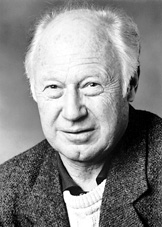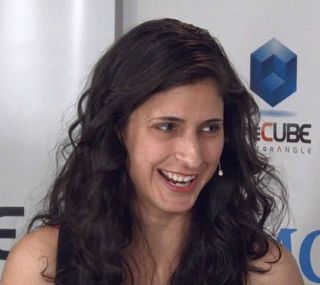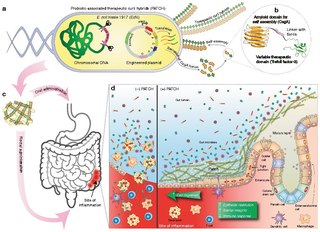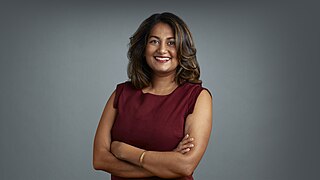Related Research Articles

Michael Smith was a British-born Canadian biochemist and businessman. He shared the 1993 Nobel Prize in Chemistry with Kary Mullis for his work in developing site-directed mutagenesis. Following a PhD in 1956 from the University of Manchester,he undertook postdoctoral research with Har Gobind Khorana at the British Columbia Research Council in Vancouver,British Columbia,Canada. Subsequently,Smith worked at the Fisheries Research Board of Canada Laboratory in Vancouver before being appointed a professor of biochemistry in the UBC Faculty of Medicine in 1966. Smith's career included roles as the founding director of the UBC Biotechnology Laboratory and the founding scientific leader of the Protein Engineering Network of Centres of Excellence (PENCE). In 1996 he was named Peter Wall Distinguished Professor of Biotechnology. Subsequently,he became the founding director of the Genome Sequencing Centre at the BC Cancer Research Centre.

The American Society for Microbiology (ASM),originally the Society of American Bacteriologists,is a professional organization for scientists who study viruses,bacteria,fungi,algae,and protozoa as well as other aspects of microbiology. It was founded in 1899. The Society publishes a variety of scientific journals,textbooks,and other educational materials related to microbiology and infectious diseases. ASM organizes annual meetings,as well as workshops and professional development opportunities for its members.

The Rockefeller University is a private biomedical research and graduate-only university in New York City,New York. It focuses primarily on the biological and medical sciences and provides doctoral and postdoctoral education. It is classified as a "Special Focus –Research Institution". Rockefeller is the oldest biomedical research institute in the United States.
A biomedical scientist is a scientist trained in biology,particularly in the context of medical laboratory sciences or laboratory medicine. These scientists work to gain knowledge on the main principles of how the human body works and to find new ways to cure or treat disease by developing advanced diagnostic tools or new therapeutic strategies. The research of biomedical scientists is referred to as biomedical research.
BioArt is an art practice where artists work with biology,live tissues,bacteria,living organisms,and life processes. Using scientific processes and practices such as biology and life science practices,microscopy,and biotechnology the artworks are produced in laboratories,galleries,or artists' studios. The scope of BioArt is a range considered by some artists to be strictly limited to "living forms",while other artists include art that uses the imagery of contemporary medicine and biological research,or require that it address a controversy or blind spot posed by the very character of the life sciences.

Christopher Voigt is an American synthetic biologist,molecular biophysicist,and engineer.
Do-it-yourself biology is a biotechnological social movement in which individuals,communities,and small organizations study biology and life science using the same methods as traditional research institutions. DIY biology is primarily undertaken by individuals with limited research training from academia or corporations,who then mentor and oversee other DIY biologists with little or no formal training. This may be done as a hobby,as a not-for-profit endeavor for community learning and open-science innovation,or for profit,to start a business.

Lucy Shapiro is an American developmental biologist. She is a professor of Developmental Biology at the Stanford University School of Medicine. She is the Virginia and D.K. Ludwig Professor of Cancer Research and the director of the Beckman Center for Molecular and Genetic Medicine.

Genspace is a non-profit organization and a community biology laboratory located in Brooklyn,New York. Stemming from the hacking,biohacking,and DIYbio movements,Genspace has focused on supporting citizen science and public access to biotechnology. Genspace opened the first community biology lab in 2010 and a Biosafety Level One laboratory in December of that year. Since its opening,Genspace has supported projects,events,courses,art,and general community resources concerning biology,biotechnology,synthetic biology,genetic engineering,citizen science,open source software,open source hardware,and more.
Anicka Yi is a conceptual artist whose work lies at the intersection of fragrance,cuisine,and science. She is known for installations that engage the senses,especially the sense of smell;and,for her collaborations with biologists and chemists. Yi lives and works in New York City.

Nina Marie Tandon is an American biomedical engineer. She is the CEO and co-founder of EpiBone. She is an adjunct professor of Electrical Engineering at Cooper Union and is a senior fellow at the Lab for Stem Cells and Tissue Engineering at Columbia. She was a 2011 TED Fellow and a 2012 senior TED Fellow.
B. Brett Finlay,is a Canadian microbiologist well known for his contributions to understanding how microbes cause disease in people and developing new tools for fighting infections,as well as the role the microbiota plays in human health and disease. Science.ca describes him as one of the world's foremost experts on the molecular understanding of the ways bacteria infect their hosts. He also led the SARS Accelerated Vaccine Initiative (SAVI) and developed vaccines to SARS and a bovine vaccine to E. coli O157:H7. His current research interests focus on pathogenic E. coli and Salmonella pathogenicity,and the role of the microbiota in infections,asthma,and malnutrition. He is currently the UBC Peter Wall Distinguished Professor and a Professor in the Michael Smith Laboratories,Microbiology and Immunology,and Biochemistry and Molecular Biology,and Co-director and Senior Fellow for the CIFAR Humans and Microbes program. He is also co-author of the book Let Them Eat Dirt:Saving Your Child from an Oversanitized World and The Whole-Body Microbiome:How to Harness Microbes - Inside and Out - For Lifelong Health. Finlay is the author of over 500 publications in peer-reviewed journals and served as editor of several professional publications for many years.

Gregory L. Verdine is an American chemical biologist,biotech entrepreneur,venture capitalist and university professor. He is a founder of the field of chemical biology,which deals with the application of chemical techniques to biological systems. His work has focused on mechanisms of DNA repair and cell penetrability.
Howard Chi Hang is an American chemist and professor in the Department of Immunology and Microbiology and Department of Chemistry at The Scripps Research Institute. He was previously Richard E. Salomon Family Associate Professor and the head of the Laboratory of Chemical Biology and Microbial Pathogenesis at the Rockefeller University in New York City. He won the Eli Lilly Award in Biological Chemistry in 2017.
Karmella Ann Haynes is a biomedical engineer and associate professor at the Wallace H. Coulter Department of Biomedical Engineering,Georgia Institute of Technology and Emory University. She researches how chromatin is used to control cell development in biological tissue.

Christina Maria Agapakis is a synthetic biologist,science writer. She is the Creative Director of the biotechnology company Ginkgo Bioworks.
Rachel Dutton is an American microbiologist. She has developed the microorganisms that live on cheese into a model system for complex interacting microbial communities. She has worked with chefs including Dan Felder,head of research and development at Momofuku to develop new fermentation procedures to be used in food and has been called the "go-to microbiologist" for chefs and gastronomists.

A living medicine is a type of biologic that consists of a living organism that is used to treat a disease. This usually takes the form of a cell or a virus that has been genetically engineered to possess therapeutic properties that is injected into a patient. Perhaps the oldest use of a living medicine is the use of leeches for bloodletting,though living medicines have advanced tremendously since that time.

Shruti Naik is an Indian American scientist who is known for her interdisciplinary research in immunology and adult stem cell biology. She is an Associate Professor of Pathology,Dermatology,and Medicine and Associate Director for the Colton Center for Autoimmunity at NYU Langone Health. Her lab combines approaches from the fields of immunology,microbiology,stem cell biology,and cancer biology with cutting-edge imaging and sequencing technologies to discover new ways of treating inflammatory diseases.
Emma Allen-Vercoe is a British-Canadian Molecular biologist who is a Professor and Canada Research Chair at the University of Guelph. Her research considers the gut microbiome and microbial therapeutics to treat Escherichia coli.
References
- ↑ "Synthetic Biological Systems Laboratory".
- ↑ "Columbia University Biomedical Engineering: Tal Danino". June 8, 2017.
- ↑ "Programming bacteria to detect cancer (and maybe treat it)". TED.com. May 2015.
- ↑ "Hacking bacteria to fight cancer". TED.com. December 2019.
- ↑ Ryzik, Melena (January 6, 2015). "Gates Foundation Uses Art to Encourage Vaccination". The New York Times.
- ↑ Sheets, Hilarie M. (March 4, 2016). "At M.I.T., Science Embraces a New Chaos Theory: Art". The New York Times.
- ↑ "The Devil Wears Pulsars". The Atlantic . January 29, 2015.
- ↑ Flaherty, Joe. "A Beautiful Wallpaper Made With Smallpox Vaccine". Wired.
- ↑ Project, The Creators (August 19, 2014). "[Video] Colonies | Vik Muniz And Tal Danino Turn Living Cells Into Art". Vice.
- ↑ Stamler, Hannah (March 17, 2015). "The Sights (and Smells) of Anicka Yi's Bacteria Art Show". Vice.
- ↑ "Beautiful bacteria". TED.com. March 26, 2024.